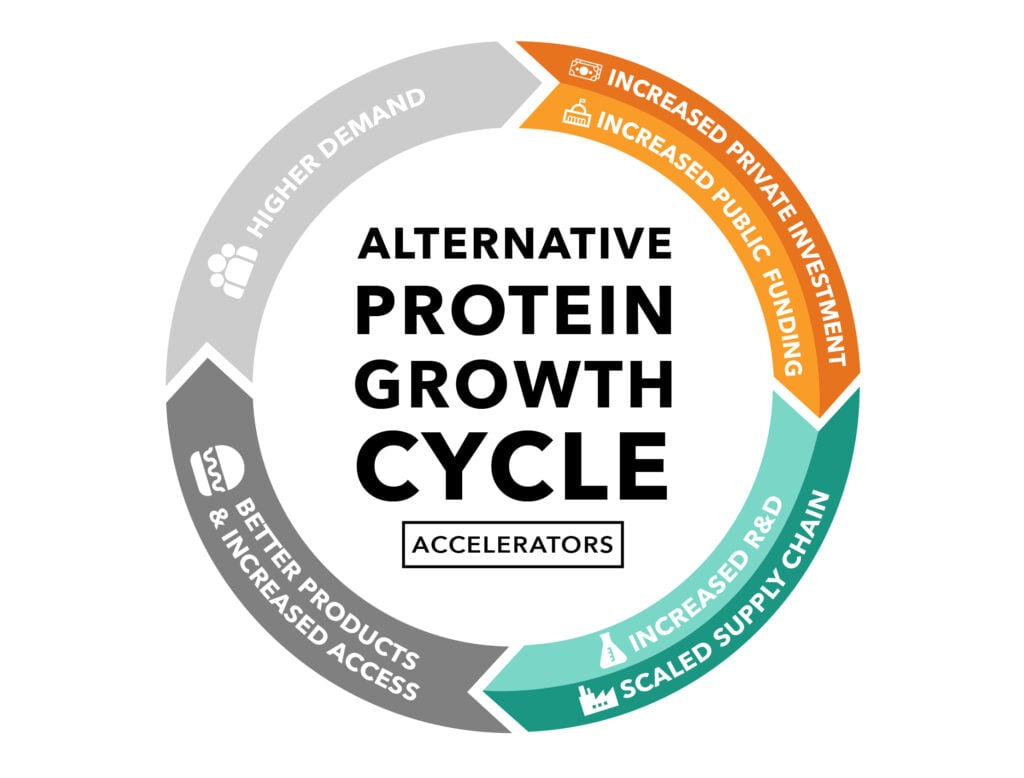New GFI initiative highlights key alt protein industry challenges and potential solutions

Since GFI first began reaching out to restaurant chains in 2017, plant-based meat has gone from relative curiosity to mainstream staple in the foodservice world. Over the past few years, brands such as TGI Fridays, White Castle, and Burger King have all launched permanent plant-based menu items. And brands like Arby’s have gotten attention just by announcing that they weren’t going to add plant-based meat.
Now, we’re no longer asking, “Is plant-based food a long-term trend?” Instead, we are posing a new question: How do we successfully capture the plant-based opportunity? GFI’s new Advancing Solutions for Alternative Proteins initiative aims to identify challenges and high-impact solutions to make alternative proteins competitive with animal proteins on three key drivers of product success: taste, price, and convenience.
Demand for alternative proteins is outpacing supply
The speed with which foodservice operators and retailers are adding plant-based products to their shelves and menus has made it clear that demand from their customers—as demonstrated by positive retail and foodservice sales results—is not holding back the alternative protein industry. Instead, the constraints are further upstream, on the supply side.
Increasingly, foodservice purchasers have shared with us that the only thing holding them back from launching plant-based meat products is the pricing and the need for additional tasty, functional, and affordable products which meet their category needs.
This situation—consumer demand for plant-based foods outpacing supply chain capabilities— supports the hypothesis that underpins all of GFI’s work: If the alternative protein industry can—at scale—produce foods that are delicious, functional, versatile, and affordable, there is a massive potential market of consumers just waiting to be tapped.
Enter the Advancing Solutions initiative.
Identifying industry challenges and sharing potential solutions
From 2019 to 2020, GFI conducted an extensive market shaping analysis that included interviewing more than 150 experts throughout the alternative protein value chain to identify the existing challenges, future bottlenecks, and potential solutions.
The experts interviewed included scientists from academia and industry, entrepreneurs, investors, marketers, consultants, and other industry leaders. These representatives were chosen from a wide variety of alternative protein companies, suppliers, and ecosystem members, with a focus on gathering diverse global perspectives across each segment of the value chain and covering the plant-based, fermentation, and cultivated protein production platforms. You can view the full list of interviewees in Appendix 3 of the full report.
Based on these extensive interviews, GFI developed the Advancing Solutions for Alternative Proteins initiative: A one-stop-shop of resources full of insights and opportunities for businesses, investors, nonprofits, academic researchers, and governments who are interested in the most high-impact ways to accelerate alternative protein development and capitalize on the opportunities offered by this growing industry. Resources include:
- Innovation priorities—An overview of commercial whitespaces, research gaps, technological needs, and investment priorities at each stage of the alternative protein value chain.
- Solutions database—A frequently updated database of ideas for new startups, commercial ventures and products, research projects, ecosystem support, and investment opportunities throughout the alternative protein space.
- Future-proofing report—Key findings from GFI’s premortem analysis of the potential threats to the widespread adoption of alternative proteins, including strategies to avoid or mitigate the most pressing risks.
- Full report—Deep dive into the Advancing Solutions initiative, including methodology and key findings.
GFI plans to refresh this industry survey on a regular basis to track new challenges and needed solutions, as well as to capture progress that is made on innovation priority areas. If you would like to be included in future rounds of this analysis, please let us know by filling out the form on the bottom of our Solutions page.
Consumer demand is driving investment for more and better products
Unsurprisingly, one of the topline takeaways from our interviews is that many alternative protein insiders are highly optimistic about the future of the industry, in spite of the many challenges they outlined. Over the past few years, we’ve seen strong consumer enthusiasm for plant-based products—even with premium pricing and variable product quality—that demonstrates pent-up demand for meat, egg, and dairy alternatives that are taste- and price-competitive with animal proteins.
This demand is driving investment from global governments, investors, and existing companies into R&D and scaling the supply chain for higher production output. Research is creating innovations that are improving product quality, including allowing for more analogous taste and texture to conventional animal-based products, increased variety, and improved functionality and versatility. And a scaled supply chain is increasing the quantity of products produced, lowering prices, and expanding availability for consumers.
By addressing technical bottlenecks, alternative protein industry players can continue to improve product quality and make those products even more accessible to consumers. In doing so, the alternative protein industry will continue to increase demand.

The industry’s challenges require effective and accessible solutions
Food and agriculture are among the largest human-made systems on the planet. Increasing our reliance on alternative proteins will require fundamental transformation of crop growth, food storage, supply chains, industry worker training, and manufacturing processes.
For alt proteins to realize their transformative potential, the industry needs more money for R&D funding, mobilizing and training a massive new workforce, and investing billions of dollars to scale processing and production infrastructure. To achieve these critical breakthroughs, we need to enable the R&D to be as effective as possible and to disseminate those insights as rapidly as possible. By identifying critical industry challenges and sharing potential solutions, GFI’s Advancing Solutions for Alternative Proteins initiative aims to enhance the alternative protein industry’s scale and speed to propel it forward.
The challenges ahead are not insignificant, but represent massive opportunities if overcome, which we are confident they will be. The early developments in this emerging industry have shown that alternative proteins are a high-potential opportunity to disrupt multi-trillion-dollar categories and an indispensable part of building a sustainable, secure, and just global food system.

